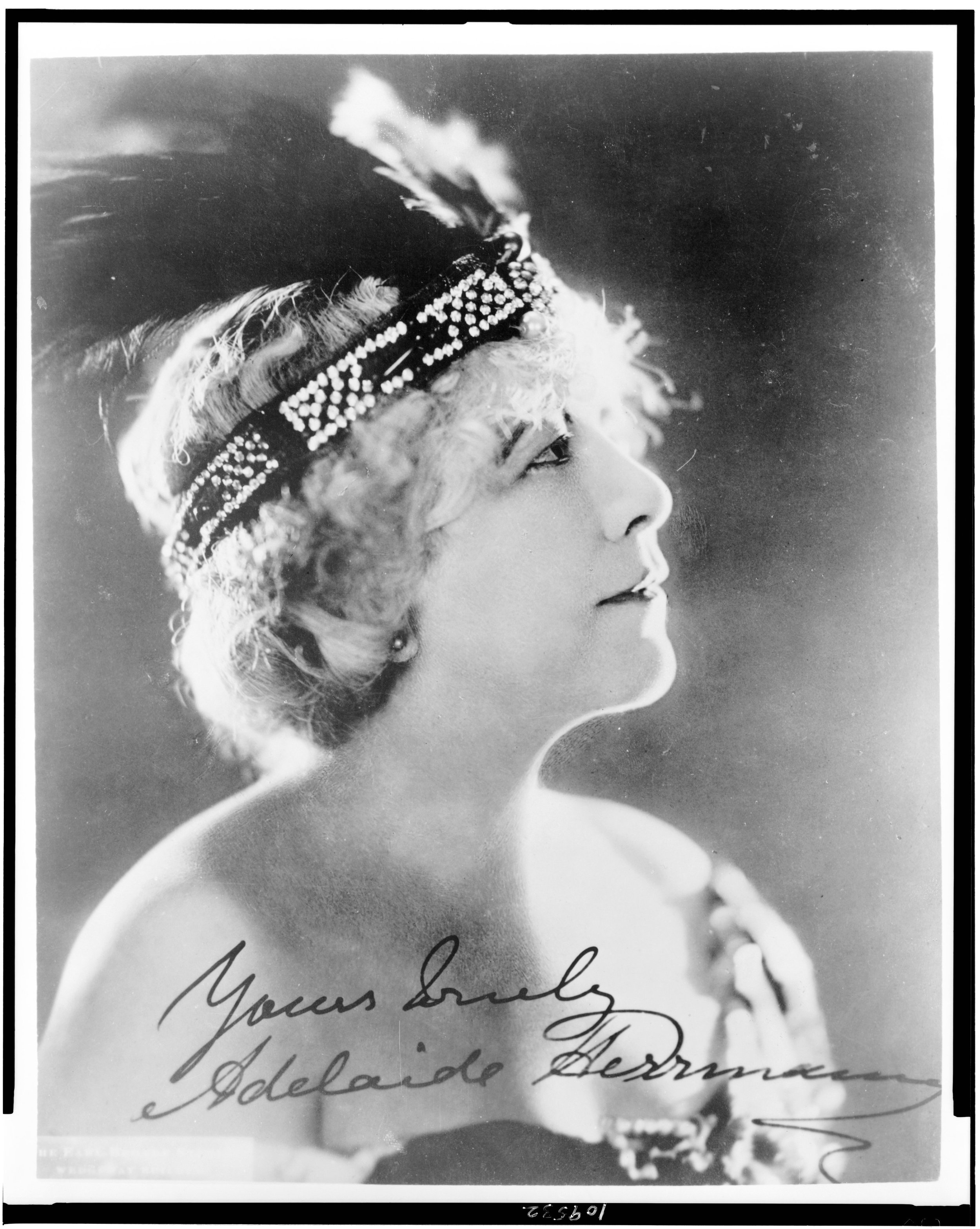
The Queen of Magic
By William Pack | Magician, Historian, and Educator, https://libraryprogramming.com/
By Miscellaneous Items in High Demand, PPOC, Library of Congress - Library of CongressCatalog: https://lccn.loc.gov/94500214Image download: https://cdn.loc.gov/service/pnp/cph/3c00000/3c09000/3c09500/3c09532v.jpgOriginal url: https://www.loc.gov/pictures/item/94500214/, Public Domain, https://commons.wikimedia.org/w/index.php?curid=68157854Adelaide Herrmann
(Adele Scarsez)
B. 1853 – D. February 19, 1932
Born in London, a teenage Adelaide (Adele Scarsez) developed a passion for dance and acrobatics. She started performing with the Kiralfy family’s dance troupe. Later, she joined Professor Brown’s Lady Velocipede Troupe as an expert trick rider of that early bicycle. In 1874, the company set sail for America.
During the voyage, she met the mischievous magician Alexander Herrmann. After two weeks of flirtation, Adelaide agreed to marry him. They quickly tied the knot in New York, and Alexander paid for the ceremony with a little sleight of hand. Besides gaining a husband, she gained a lifelong passion--magic.
At a time when female assistants were only seen as little more than stage dressing and subordinate helpers, Adelaide received equal billing to her husband and took a leading role in many illusions. She also performed solo spots, featuring her trick cycling skills and staging artistic dance routines. In “Lily of the Orient,” Adelaide mimed a Calla Lily in bloom, and in ‘La Danse de Vesuvius,” she spun so fast in a costume of yellow and red silk squares that she looked like a column of fire.
The Herrmanns toured the world throughout the 1870s and 1880s, with Adelaide being levitated, vanished, dismembered, and cremated on a nightly basis. When the human cannonball unexpectedly left the show, Adelaide stepped into the dangerous role. Once, she was accidentally set on fire by the giant cannon’s gunpowder; another time, she dislocated her shoulders when she landed badly in the net.
Adelaide and Alexander lived an extravagant life together, with a mansion on Long Island, a private yacht, and a luxurious train car. The good times came to an end when, in December 1896, Alexander suffered a heart attack and died at age fifty-two. The grieving widow was left with considerable debts.
Heartbroken, Adelaide reinvented herself as the Queen of Magic. She toured with her nephew Leon Herrmann, who came from Europe for a while. Leon thought himself the star, but Adelaide ran the show. After a few years, Leon returned to France, unwilling to be bossed around by his headstrong partner. Adelaide went solo and became Magic’s first female headliner.
Adelaide went solo
and became Magic’s
first female headliner.
She transformed her full evening show into a shorter, faster-paced act suitable for the short vaudeville turns. Many of her illusions involved large apparatus and volumes of animals.
Her “Noah’s Ark” illusion was her greatest hit. At first, an ark was shown empty, and then buckets of water symbolizing the flood were poured down its chimney. Soon, two cats, one black and one white, climbed from the chimney, then a gangplank emerged over which prowled a parade of birds, leopards, lions, tigers, zebras, and elephants. The birds were real; the other animals were dogs in costumes. A flock of white doves flew from the windows, and the biblical boat opened to reveal a lounging woman dressed in white.
In 1897, she recreated her husband's bullet catch trick while performing at the Grand Opera House in Chicago. Perhaps the first woman to perform the murderous stunt. Adelaide appeared on stage dressed in trousers and a white blouse — the uniform of a magician, not an assistant.
“Poignant memories assailed me as, the overture being finished, the curtain rose to the familiar strains of the lovely Strauss waltz which my husband was accustomed to use for his opening accompaniment,” she wrote. “I began to feel faint; my emotion was almost too much for me.”
There was no time for reminiscing. She had a date with a firing squad. A line of riflemen joined her on stage as Adelaide asked the crowd to inspect their bullets, each of which had a unique mark. The guns were then loaded and aimed at Adelaide. The audience held its breath. The guns fired. The smoke cleared, and Adelaide was still standing — the marked bullets, still hot, clutched in her hands. The crowd leaped to their feet and roared.
In a November 2, 1899, article for Broadway Magazine entitled “The World’s Only Woman Magician,” Adelaide proclaimed, “I shall not be content until I am recognized by the public as a leader in my profession, and entirely irrespective of the question of sex.” She became a top headliner around the world for the next twenty-five years. She also challenged the convention of the new young thing, touring with her popular act well into her 70s.
I shall not be content
until I am recognized by the public as a leader in my profession,
and entirely irrespective of the question of sex.
In 1926, Adelaide moved her apparatus and animals into a theatrical warehouse. That September, the warehouse caught fire. All was lost, including her beloved animals and their trainer. If you are a showman, the show must go on. She created a smaller show called “Magic, Grace, and Music,” highlighting the three elements at which she’d excelled in her career. She finally retired in 1928. Four years later, she passed away from pneumonia. Adelaide was 79 years old.
Throughout her career, Adelaide encouraged other women to study the art of magic. She published articles that showed women how to perform miracles. When a fan wrote her asking for advice, she replied: “I see no reason why you should not become a good artiste of legerdemain. While there are few who have made the art a study, still we must remember that this is the new era for women.”


